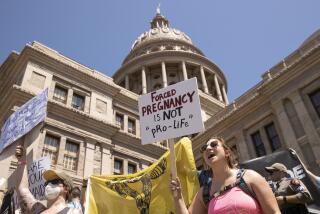Teen births hit new low as pregnancy prevention programs pay off
Teen births have fallen to record lows in the United States, continuing an overall trend -- partly due to programs aimed at preventing pregnancies among teenagers, the federal Centers for Disease Control and Prevention reported on Tuesday.
The U.S. teen birth rate declined 9% from 2009 to 2010, reaching 34.3 births per 1,000 women ages 15-19, the CDC reported. From 1991 through 2010, the rate dropped by 44%.
Teen child-bearing has been generally on a long-term decline in the United States since the late 1950s, but the United States continues to have one of the highest such rates among industrialized countries. Teen mothers and their offspring have more health risks than older women and their offspring, adding about $10.9 billion to public health costs each year, the agency said.
The highest rate was again recorded in Mississippi at 55 births per 1,000 teenagers. But even there, the rate has fallen by 21% over three years, according to the data.
The lowest rate was in New Hampshire, 15.7 births per 1,000.
Nearly every state saw a decline in teen births from 2007 to 2010, with the biggest drop, 29%, in Arizona. Rates stayed about the same in three states: Montana, North Dakota and West Virginia.
In general, rates tended to be highest in the South and Southwest and lowest in the Northeast and Upper Midwest, a pattern that has persisted for many years, the data showed.
Fewer babies were born to teenagers in 2010 than in any year since 1946. If the teen birth rates observed in 1991 had not declined through 2010, there would have been an estimated 3.4 million additional births to teens during 1992–2010.
The declines have generally been attributed to the increase of pregnancy prevention messages directed at teenagers. Recently released data from the National Survey of Family Growth, conducted by the CDC’s National Center for Health Statistics, have shown increased use of contraception at first initiation of sex and use of dual methods of contraception.
ALSO:
Amazon.com: Internet giant sleeping in Seattle?
Suspects in Tulsa killing rampage admit guilt, say police
Destined to be great? 13-year-old grabs wheel, saves school bus
More to Read
Sign up for Essential California
The most important California stories and recommendations in your inbox every morning.
You may occasionally receive promotional content from the Los Angeles Times.











